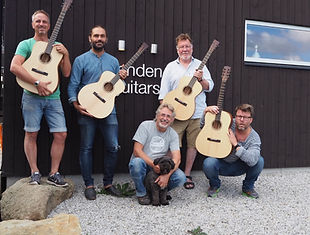Hands-on guitar building
Have you always wanted to build your own guitar? But thought it is to hard or you do not have the space or tools to do it? Well here is your chance to have your dream come thru. With professional guidance I help you thru all the steps and you walk away with a complete instrument including a beautiful satin finish lacquer.
Working from the raw materials, you’ll create the parts, construct the sub-assemblies, assemble, shape, trim, sand, laquering, set up and finally play your guitar, learning each phase of the process in turn, in real time at your workbench. The hands-on class experience is designed to give a clear understanding of what is needed to make instruments.
Each student creates his or her own instrument as each step is discussed and demonstrated. Enrollment is limited to five students. The classes run for two weeks and I hold two classes a year. We work full time, from 09.00-17.00 every day including weekends. No lutherie or woodworking experience is required
.
Please email michael@sandenguitars.com with any questions, or call +46 708915549 to speak with me personally.
Schedule 2024
Class 1 6th-17th of Maj FULL
Class 2 5th-16th of August. FULL
Cost and Lodging
The price is 26000 sek including materials. I charge a 2000 sek sign up fee,
which will be deducted from the total price.
If you, for some reason, cannot attend the class you have signed up for,
and it is less than two months before the class starts, we will have to charge
for the full class except for the materials.
If you want you can buy a hardcase and a pick-up as well at additional cost.
Lodging is not included within the price. We can help you finding a suitable B&B in the area close to the workshop. pls call!
What guitar models can I build?
You can choose from four different models. A dreadnought, a classical , a 000Martin
and a Gibson L00 1940. See pictures below
About the guitars we build at the classes
You can choose from four different model (see below),
A dreadnought or sloped shoulder fig.1.
A classical model fig. 2.
A 000-Martin fig. 3
A 00-Gibson fig.4
You can choose to have a 12 or 14 fret neck (how many frets free of the body). You can also choose to have a solid or and open headstock. You can make your own head and bridge shapes (within certain limits). You decide how wide and thick the neck should be (so it fits your needs).
The material we use (see below) is carefully selected by me and it is dried for at least three year in my workshop. I get questions if it is possible to choose some other typ of wood, like rosewood for instance, well no. Now a days the are so many regulations regarding rosewood to import that I have decided not to offer that. However the mahogny we are using, is the best there is and I can guaranty you that it will look stunning and it will make a very well balanced guitar.
I also get a lot of questions regarding the lacquer, and I want to explain a little about it. We make the guitar in a satin lacquer. It is a strong cellulose typ of lacquer. The reason we can not make high gloss guitars is the time (and skills). To make a high gloss guitar takes a lot of practice. The high gloss lacquering process takes about five to six days. Then the guitar will have to dry for at least ten days, then there is about one day of wet sanding and buffing. So time wise it is not possible. Some people ask if they can buff it up when they come home? It is possible but it will not look nice. Because the satin lacquer will be "milky" and not clear.
Materials included:
Top Sitka Spruce
Back and sides Sapele Mahogany
Neck Mahogany
Fretboard Ebony
Bindings Wood
Tuners Schertler
Finish Satin












